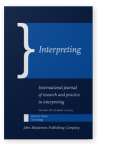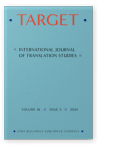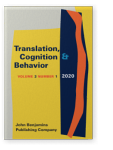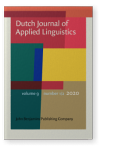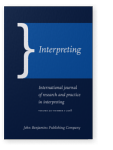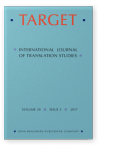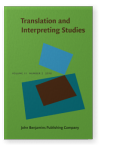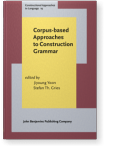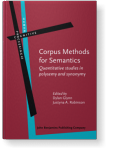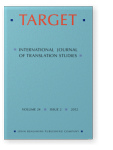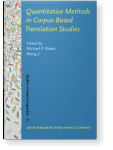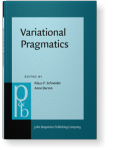Koen Plevoets
List of John Benjamins publications for which Koen Plevoets plays a role.
Journals
2020 Choosing to become an interpreter: A matter of personality and memory capacity? Translation, Cognition & Behavior 3:1, pp. 25–50 | Article
Within the world of interpreting, persistent clichés exist about an interpreter’s required personality and cognitive traits. For instance, an interpreter is thought to be communicative, stress-resistant and to have excellent memory skills. Yet, while research has been conducted into interpreters’… read more
2020 Dutch speech intelligibility in bilingual Turkish-Dutch children in Flanders Dutch Journal of Applied Linguistics 9:1/2, pp. 215–235 | Article
This study examines the Dutch intelligibility of a group of monolingual Dutch and bilingual Turkish-Dutch preschool children in Flanders, as rated by native Dutch listeners and measured by a Dutch intelligibility test. The intelligibility of the bilingual children is compared to that of the… read more
2018 The cognitive load of interpreters in the European Parliament: A corpus-based study of predictors for the disfluency uh(m) Interpreting 20:1, pp. 1–32 | Article
Cognitive load is a major source of processing difficulties in both interpreting and monolingual speech. This article focuses on measurement of cognitive load by examining the occurrence rate of the disfluency uh(m) in two corpora of naturalistic language: the EPICG, with specific reference to… read more
2017 A corpus-based study of semantic differences in translation: The case of inchoativity in Dutch Target 29:3, pp. 388–415 | Article
This paper presents a corpus-driven, statistical method for the visualization of semantic structure, thereby tackling the under-researched issue of semantics in corpus-based Translation Studies. We aim to investigate the influence of translation on the structure of semantic fields and in… read more
2016 The effect of informational load on disfluencies in interpreting: A corpus-based regression analysis Translation and Interpreting Studies 11:2, pp. 202–224 | Article
This article attempts to measure the cognitive or informational load in interpreting by modelling the occurrence rate of the speech disfluency uh(m). In a corpus of 107 interpreted and 240 non-interpreted texts, informational load is operationalized in terms of four measures: delivery rate, lexical… read more
2016 A multifactorial analysis of that/ zero alternation: The diachronic development of the zero complementizer with think, guess and understand Corpus-based Approaches to Construction Grammar, Yoon, Jiyoung and Stefan Th. Gries (eds.), pp. 201–240 | Article
This corpus-based study uses a stepwise logistic regression analysis to examine
the diachronic development of that/zero alternation with three verbs of cognition,
viz. think, guess and understand in both spoken and written corpora from
1560–2012. Eleven structural features which have been claimed… read more
2014 Competing ‘transfer’ constructions in Dutch: The case of ont-verbs Corpus Methods for Semantics: Quantitative studies in polysemy and synonymy, Glynn, Dylan and Justyna A. Robinson (eds.), pp. 39–60 | Article
This paper zooms in on the semantic relations between the constructions of
“possessional transfer” (i.e. constructions used to encode events of possessional
transfer) in Dutch by zooming in on a specific morphological class of dispossession
verbs, viz. verbs with the prefix ont- ‘away’, such as… read more
2014 A diachronic corpus-based multivariate analysis of “I think that” vs. “I think zero” Corpus Methods for Semantics: Quantitative studies in polysemy and synonymy, Glynn, Dylan and Justyna A. Robinson (eds.), pp. 279–303 | Article
This corpus-driven study seeks to explain the choice between the zero complement and the that complement constructions, when occurring with the mental state predicate think. Previous studies have identified a range of factors that are argued to explain the alternation patterns. Such studies have… read more
2012 Is translated language more standardized than non-translated language? Using profile-based correspondence analysis for measuring linguistic distances between language varieties. Target 24:2, pp. 203–224 | Article
With this article, we seek to support the law of growing standardization by showing that texts translated into Belgian Dutch make more use of standard language than non-translated Belgian Dutch texts. Additionally, we want to examine whether the use of standard vs. non-standard language can be… read more
2012 Lexical lectometry in corpus-based translation studies: Combining profile-based correspondence analysis and logistic regression modeling Quantitative Methods in Corpus-Based Translation Studies: A practical guide to descriptive translation research, Oakes, Michael P. and Meng Ji (eds.), pp. 325–346 | Article
The present study addresses the long-standing issue in corpus-based translation studies that translated texts differ from non-translated texts in the same language, irrespective of text type or source language. We investigate whether this claim is empirically verifiable for a variety of lexical… read more
2008 The distribution of T/V pronouns in Netherlandic and Belgian Dutch Variational Pragmatics: A focus on regional varieties in pluricentric languages, Schneider, Klaus P. and Anne Barron (eds.), pp. 181–209 | Article
